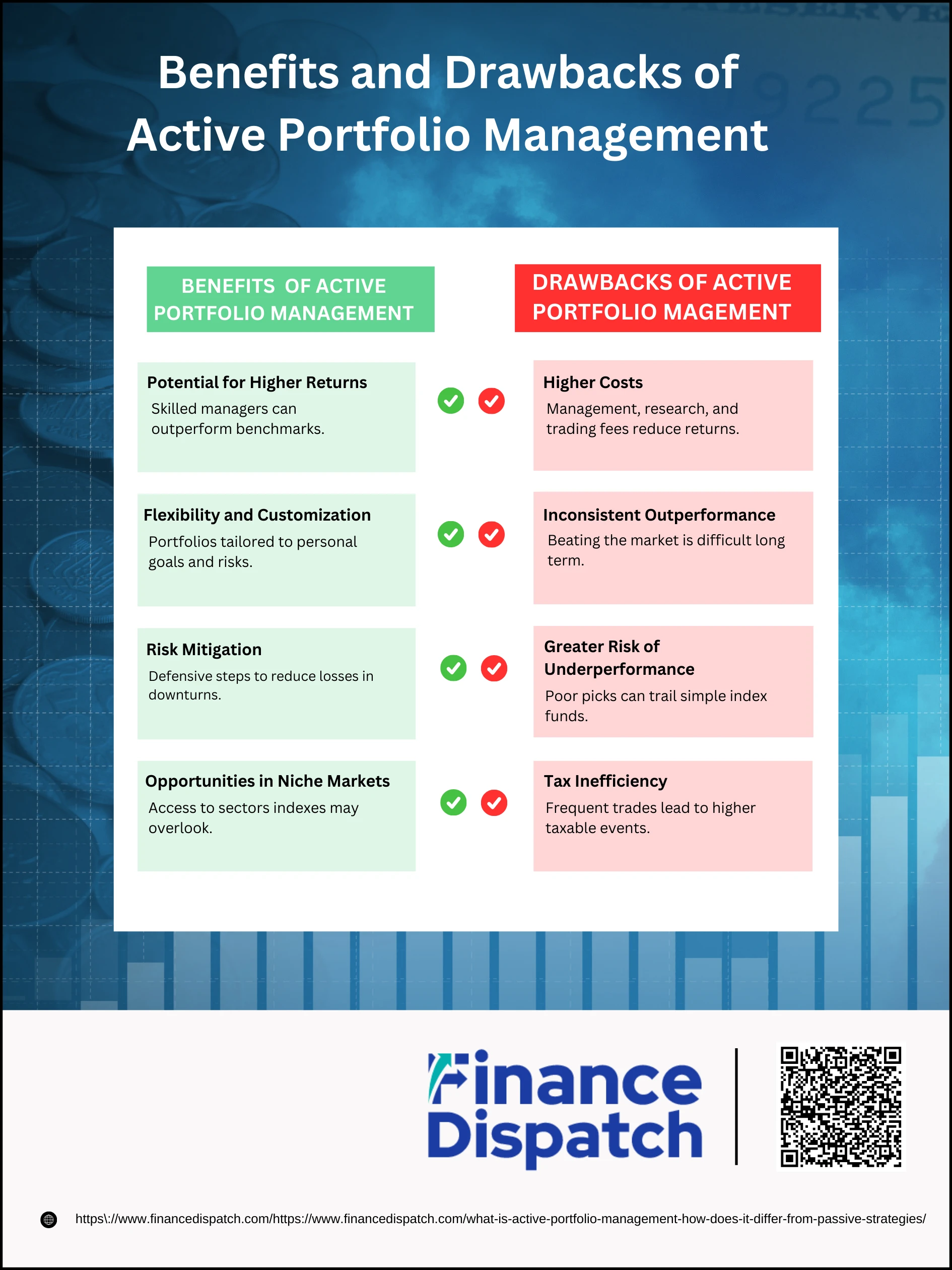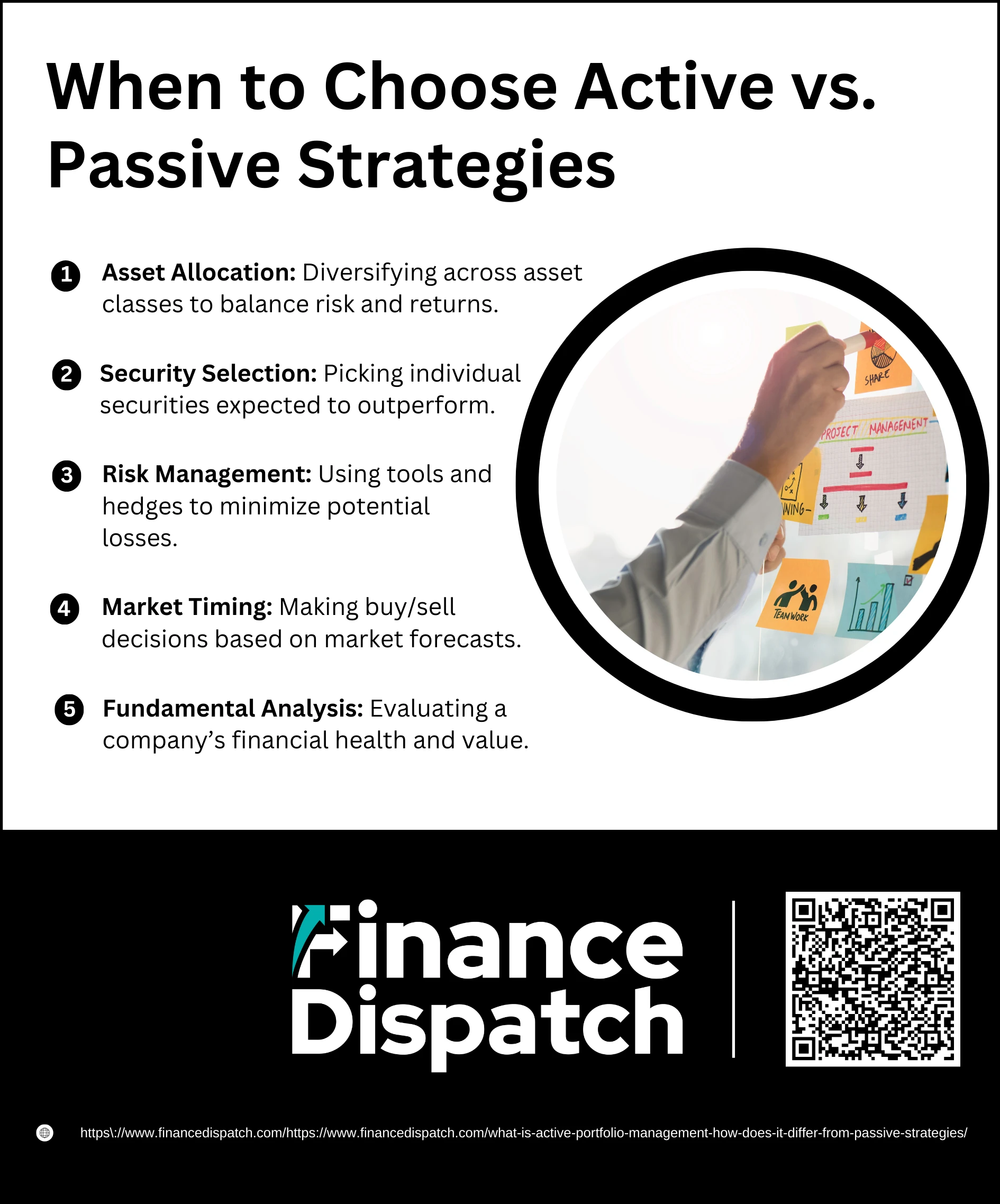When it comes to investing, one of the first choices you’ll face is whether to take a hands-on approach or let the market do most of the work. This is where the debate between active and passive portfolio management comes in. Active portfolio management is all about carefully selecting securities and adjusting asset allocations to outperform market benchmarks, while passive management simply tracks an index to deliver market-matching results. Both strategies have their own strengths, risks, and costs, and understanding how they differ is essential for aligning your investment plan with your financial goals and risk tolerance.
What is Active Portfolio Management?
Active portfolio management is a hands-on investment approach where the goal is to outperform market benchmarks such as the S&P 500. Instead of simply following an index, portfolio managers or individual investors actively buy and sell securities based on research, market trends, and economic indicators. This strategy involves constant monitoring of investments, analyzing financial data, and making timely decisions to capture opportunities or avoid risks. The main objectives are twofold: to generate higher returns than the overall market and to reduce potential losses through strategic asset allocation and security selection.
 Techniques and Strategies in Active Portfolio Management
Techniques and Strategies in Active Portfolio Management
Active portfolio management relies on a range of strategies aimed at maximizing returns while controlling risk. Unlike passive investing, where the goal is simply to mirror the market, active managers continuously analyze data, adjust allocations, and make informed decisions to stay ahead of benchmarks. Below are the key techniques used:
1. Asset Allocation
Asset allocation is about spreading investments across various asset classes such as stocks, bonds, commodities, or cash. The idea is to create a balance that reflects the investor’s goals and risk appetite. For example, in a volatile market, a manager may reduce equity exposure and increase bond holdings to preserve capital. Adjusting the mix of assets allows managers to adapt quickly to market conditions.
2. Security Selection
This technique focuses on picking the right individual securities—stocks, bonds, or other instruments—that are expected to outperform. Managers may rely on company research, financial ratios, or industry trends to identify undervalued opportunities. For instance, investing in a company with strong earnings growth and low debt may signal potential for better returns compared to peers.
3. Risk Management
Since active investing involves frequent trades, managing risk is crucial. Portfolio managers use tools like stop-loss or stop-limit orders that automatically sell securities if prices fall below a set point. They may also use derivatives such as options or futures to hedge against market swings. These methods protect portfolios from heavy losses while maintaining exposure to growth opportunities.
4. Market Timing
Market timing involves making buy or sell decisions based on forecasts of market trends. Managers often track economic indicators like inflation rates, GDP growth, or employment data to predict shifts. They may also watch global events such as elections or trade disputes that could impact markets. The goal is to capitalize on favorable short-term movements while avoiding downturns.
5. Fundamental Analysis
Fundamental analysis digs deep into a company’s financial health. Managers analyze balance sheets, income statements, revenue growth, and debt levels to estimate a stock’s intrinsic value. They also assess qualitative factors such as leadership quality and competitive advantage. If the market undervalues a company compared to its true worth, it may present a profitable investment opportunity.
6. Technical Analysis
Unlike fundamental analysis, technical analysis focuses on price charts and trading patterns. Managers look at historical data, moving averages, and momentum indicators to spot trends. For example, a consistent upward trend may signal a buying opportunity, while repeated resistance at a price level may suggest it’s time to sell. This method is particularly useful for short-term trading decisions.
 Benefits and Drawbacks of Active Portfolio Management
Benefits and Drawbacks of Active Portfolio Management
Active portfolio management can be attractive because of its promise of higher returns and flexibility. At the same time, it carries risks and costs that may outweigh its advantages for certain investors. Below is a closer look at the benefits and drawbacks in detail.
Benefits
1. Potential for Higher Returns
The core appeal of active management lies in its ability to outperform market benchmarks. Skilled managers can identify undervalued stocks, capitalize on market inefficiencies, and take advantage of short-term opportunities. For example, during times of volatility, an active manager might sell risky assets early and buy into safe havens, generating returns beyond what a passive index would deliver.
2. Flexibility and Customization
Active strategies allow portfolios to be tailored around an investor’s personal goals, risk tolerance, and investment horizon. This flexibility is especially useful for investors with specific needs, such as socially responsible investing or sector-specific exposure, where passive funds may not offer the right fit.
3. Risk Mitigation
Active managers can take defensive steps in response to market downturns. By rebalancing allocations, setting stop-loss orders, or using hedging instruments like options, they can minimize potential losses. This proactive approach may help preserve capital during sharp declines, which passive portfolios must fully absorb.
4. Opportunities in Niche Markets
Passive strategies usually track large, well-established indices. Active managers, however, can explore less-tracked or emerging sectors such as green energy, biotech, or frontier markets. These areas often provide opportunities for significant growth that an index fund might miss, giving investors an edge.
Drawbacks
1. Higher Costs
Active management typically comes with higher fees. These include portfolio manager salaries, research expenses, trading costs, and performance-based charges. Over time, such costs can erode returns, especially when compared with low-cost passive funds.
2. Inconsistent Outperformance
Beating the market consistently is extremely difficult. Even experienced managers with strong track records may struggle to deliver sustained outperformance. Markets are unpredictable, and one poor decision can offset years of gains.
3. Greater Risk of Underperformance
Active management doesn’t just carry the chance of underperformance—it often results in it. Because managers try to predict future market moves, incorrect forecasts or poor stock picks can leave investors with returns below those of a simple index fund.
4. Tax Inefficiency
Frequent trading leads to more taxable capital gains. Short-term trades are often taxed at higher rates, which can eat into an investor’s after-tax returns. By contrast, passive strategies tend to hold securities longer, deferring taxes and improving overall efficiency.
What is Passive Portfolio Management?
Passive portfolio management is a long-term investment strategy that aims to match, rather than beat, the performance of a market index such as the S&P 500 or Nasdaq. Instead of making frequent trades, investors buy index funds or exchange-traded funds (ETFs) that mirror the holdings and weightings of a chosen benchmark. Because this approach does not rely on constant research or active decision-making, it typically comes with lower fees, minimal trading costs, and greater tax efficiency. The goal is to achieve steady, market-level returns over time, making it a simple and cost-effective choice for investors who prefer a hands-off approach.
Active vs. Passive: Key Differences
When deciding between active and passive portfolio management, it’s important to understand how the two strategies differ in their goals, costs, risks, and overall approach. Active management focuses on beating the market through research and frequent trades, while passive management aims to mirror the market at lower costs with minimal involvement. The table below highlights the major differences side by side.
| Feature | Active Management | Passive Management |
| Goal | Outperform the market benchmark | Match the market benchmark |
| Management Style | Hands-on, frequent trading | Hands-off, minimal trading |
| Costs & Fees | Higher due to research, management, and trading | Lower due to minimal trading and oversight |
| Risk Level | Higher, depends on manager’s skill and timing | Market-level risk, less flexibility |
| Returns | Potentially higher but inconsistent | Market-average, steady over time |
| Tax Efficiency | Less efficient due to frequent trades | More efficient with fewer taxable events |
| Transparency | Varies depending on manager decisions | High, as portfolios track well-known indices |
 When to Choose Active vs. Passive Strategies
When to Choose Active vs. Passive Strategies
The choice between active and passive investing is not one-size-fits-all. It depends on your goals, comfort with risk, time horizon, and how much involvement you want in managing your portfolio. Let’s break down the scenarios where each approach—or even a combination—might be right for you.
1. Choose Active if You Want Higher Return Potential
Active portfolio management is best suited for investors who are aiming to beat market averages. By researching undervalued stocks, using market timing, or exploring unique opportunities, active managers can generate higher-than-index returns. For example, during market volatility, an active manager may identify strong companies trading at temporary discounts, giving investors a chance at superior gains.
2. Choose Active if You Need Flexibility
Markets change constantly, and active strategies allow managers to adapt quickly. They can reallocate funds into safer assets during downturns or shift towards growth sectors during economic booms. This flexibility is valuable for investors with short-term goals, those who want targeted exposure to industries like technology or green energy, or those seeking defensive positions in uncertain times.
3. Choose Passive if You Prefer Lower Costs
Passive investing is cost-effective. Since index funds and ETFs only track benchmarks, they require less management and research. This translates into lower expense ratios and fewer transaction costs, which, over decades, can significantly improve overall returns. For investors focused on keeping costs down, especially beginners or retirees, passive funds are often a better fit.
4. Choose Passive if You Value Simplicity
Passive strategies are ideal for investors who don’t want the stress of monitoring the market or hiring expensive fund managers. Once you invest in an index fund, your portfolio mirrors the performance of the broader market, requiring minimal adjustments. This “set it and forget it” style is especially appealing if you’re looking for long-term stability and steady growth without constant oversight.
5. Consider a Blended Approach
Many investors find that combining active and passive strategies offers the best of both worlds. A common approach is to allocate most of the portfolio to low-cost passive funds for stability and use a smaller portion for active management to seek extra returns. For example, you might keep 80% of your portfolio in an S&P 500 index fund for broad exposure and allocate 20% to an actively managed fund targeting emerging markets or niche sectors. This balance helps spread risk while capturing opportunities for growth.
Conclusion
Active and passive portfolio management represent two very different approaches to investing, each with its own strengths and limitations. Active management offers the potential for higher returns, flexibility, and tailored strategies but comes with higher costs and greater risk. Passive management, on the other hand, provides simplicity, lower fees, and consistent market-level performance, making it attractive for long-term, cost-conscious investors. Ultimately, the right choice depends on your financial goals, risk tolerance, and the level of involvement you want in managing your investments. For many, a blended approach that combines the stability of passive funds with the opportunities of active strategies can strike the best balance between growth and security.



